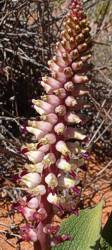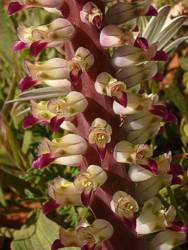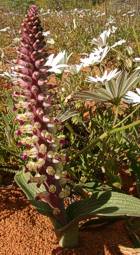Lachenalia valeriae
Lachenalia valeriae G.D.Duncan
Family: Hyacinthaceae
Common names: viooltjie (Afrikaans)
Introduction
Lachenalia valeriae is a beautiful species from the coastal dunes of Namaqualand.

Description
Description
Lachenalia valeriae is a winter-growing, perennial geophyte up to 350 mm high. The two leaves are lanceolate and on the upper surface distinct veins and minute pustules can be seen. The inflorescence is an erect, dense spike of sessile flowers. The peduncle (flowering stem) is brownish purple, especially the upper part. The flowers appear between July and August and are whitish to yellow-green with a magenta lower tip to the inner segments (see L. framesii). The stamens are included within the perianth (shorter or just as long as perianth) and the seeds are shiny and black.


Distribution and habitat
Distribution description
Lachenalia valeriae is endemic to the Northern Cape and is only found in deep red sand on the coastal dunes in the Succulent Karoo Biome. Its known distribution ranges from the Holgat River Mouth in the north to Namaqua National Park in the south.
Derivation of name and historical aspects
History
The genus Lachenalia consists of ± 117 species which are concentrated in the winter rainfall areas and are almost exclusively a winter-growing group. The name Lachenalia commemorates Werner de Lachenal, a professor from Basel, Switzerland. The specific epithet, valeriae, honours Valerie Fay Anderson in recognition of the valuable watercolour paintings she has contributed to the botanical world.
Lachenalia valeriae was described more than 30 years after it was first collected in 1970 by Mr Walter Wisura in the Port Nolloth area.
Ecology
Ecology
The inflorescences are grazed by tortoises.
Uses
Use
The whole genus Lachenalia has horticultural potential and is especially suitable for growing in containers.

Growing Lachenalia valeriae
Grow
Lachenalia valeriae has great horticultural potential as a container plant, due to the beautiful flowers and the interesting, pustulate leaves. It is easily cultivated in lightly shaded or sunny positions. As with the rest of the genus, it prefers good drainage (preferably sand/compost mix). Plant the bulbs in autumn (March to April) and water well once every fortnight. Fresh seed germinates within four weeks and should be sown in mid-autumn. At the end of spring, the yellowing of the leaves will indicate the beginning of the dormant period and watering should be withheld completely. Containers should then be stored in a cool, dry place till the next autumn. No special feeding is necessary.
References
- Duncan, G.D. 2003. Lachenalia valeriae. Flowering Plants of Africa 58: 30 - 36.
- Duncan,G.D & Edwards, T.J. 2002. A new species of Lachenalia from Namaqualand, South Africa (Hyacinthaceae: Massonieae). Bothalia 32,2: 190 - 192.
- Leistner, O.A. (ed.). 2000. Seeds plants of southern Africa: families and genera. Strelitzia 10. National Botanical Institute, Pretoria.
- Smith, C.A. 1966. Common names of South African plants. Memoirs of the Botanical Survey of South Africa No. 35.
Credits
Hester Steyn
National Herbarium Pretoria
November 2009
Plant Attributes:
Plant Type: Bulb
SA Distribution: Northern Cape
Soil type: Sandy
Flowering season: Winter
PH: Acid, Neutral
Flower colour: Yellow, Mauve/Lilac
Aspect: Full Sun, Morning Sun (Semi Shade)
Gardening skill: Average
Special Features:
Horticultural zones








Rate this article
Article well written and informative
Rate this plant
Is this an interesting plant?
Login to add your Comment
Back to topNot registered yet? Click here to register.